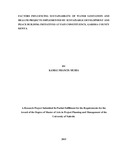| dc.description.abstract | Non-Governmental Organisations intervene in community development on different
levels of operation. Sustainability is the ability of an organization to develop a strategy of
growth and development that continues to function indefinitely. Research has shown that
projects implementation in sub-Saharan Africa; often demonstrate low levels of
sustainability. The key causes for this include inappropriate legislation; insufficient
institutional support; unsustainable financing mechanisms; ineffective management systems;
and lack of technical backstopping. This study therefore seeks to determine factors
influencing sustainability of water sanitation and health projects implemented by Sustainable
Development and Peace Building Initiatives at Fafi Constituency, Garissa County Kenya.
The study served as a guide to development practitioners to design and implement
sustainable development interventions in the area under study to improve on the life and
livelihood of beneficiary communities. Further findings of the study helped donors to
determine which areas of intervention need to be emphasized to bring about the necessary
growth and development. This study adopted a descriptive survey. The study hence considers
a survey design suitable since data was gathered from the various projects being undertaken
by SYPD. The study examined a sample of staff drawn from the population of 32
management staff working at SYPD and 100 household beneficiaries in Fafi Constituency,
Garissa County Kenya. A sample size of 112 respondents was picked for this study. With
respect to project sustainability, this study utilized a questionnaire and an interview guide to
collect primary data. This study collected both qualitative and quantitative data using a selfadministered
questionnaire and an interview guide. Before processing the responses, the
completed questionnaires were edited for completeness and consistency. The data was then
coded to enable the responses to be grouped into various categories. Data collected was
quantitative and qualitative and was analyzed by descriptive analysis and content analysis.
Descriptive statistical tools were used to analyze quantitive data whereby computers
software‟s were used to generate tabulations, percentages, and measures of central tendency.
Tables were used to present responses and facilitate comparison. Qualitative data was
analyzed using narratives statements based on the relevant thematic areas and the findings
given in prose form. In descriptive statistics, the study used frequency, mean, standard
deviation and percentages. The analyzed data was then presented in tables and figures. On
the other hand, qualitative data was analyzed by use of content analysis and results presented
in prose. The study concludes that there is a significant positive influence of community
participation, technical expertise, funds utilization and political factors on sustainability of
water sanitation and health projects. The study therefore recommends that the policy makers
should ensure that the policies are favorable to the private sectors to make them have the will
to participate in the project. The study also recommends that all the staff should be frequently
trained to acquire the right skill to enhance expertise in execution of responsibilities. The
research suggests that the same studies should be conducted on the other parts of the country
to enhance better sustainability of water sanitation and health projects in all parts of the
country. | en_US |

